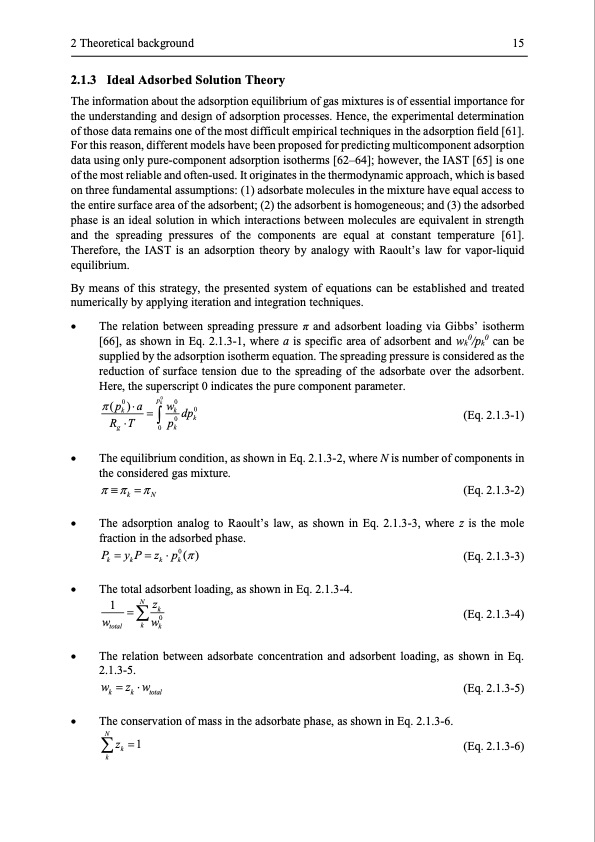
PDF Publication Title:
Text from PDF Page: 028
2 Theoretical background 15 2.1.3 Ideal Adsorbed Solution Theory The information about the adsorption equilibrium of gas mixtures is of essential importance for the understanding and design of adsorption processes. Hence, the experimental determination of those data remains one of the most difficult empirical techniques in the adsorption field [61]. For this reason, different models have been proposed for predicting multicomponent adsorption data using only pure-component adsorption isotherms [62–64]; however, the IAST [65] is one of the most reliable and often-used. It originates in the thermodynamic approach, which is based on three fundamental assumptions: (1) adsorbate molecules in the mixture have equal access to the entire surface area of the adsorbent; (2) the adsorbent is homogeneous; and (3) the adsorbed phase is an ideal solution in which interactions between molecules are equivalent in strength and the spreading pressures of the components are equal at constant temperature [61]. Therefore, the IAST is an adsorption theory by analogy with Raoult’s law for vapor-liquid equilibrium. By means of this strategy, the presented system of equations can be established and treated numerically by applying iteration and integration techniques. • The relation between spreading pressure π and adsorbent loading via Gibbs’ isotherm [66], as shown in Eq. 2.1.3-1, where a is specific area of adsorbent and wk0/pk0 can be supplied by the adsorption isotherm equation. The spreading pressure is considered as the reduction of surface tension due to the spreading of the adsorbate over the adsorbent. Here, the superscript 0 indicates the pure component parameter. (Eq. 2.1.3-1) the considered gas mixture. k =N (Eq.2.1.3-2) • The adsorption analog to Raoult’s law, as shown in Eq. 2.1.3-3, where z is the mole fraction in the adsorbed phase. 0k0 (p)a p0w k = k dp0 0k RgT 0pk • The equilibrium condition, as shown in Eq. 2.1.3-2, where N is number of components in P =y P=z p0() kkkk • The total adsorbent loading, as shown in Eq. 2.1.3-4. • The relation between adsorbate concentration and adsorbent loading, as shown in Eq. 2.1.3-5. 1Nz =k (Eq.2.1.3-3) (Eq. 2.1.3-4) w w0 total k k w =z w k k total • The conservation of mass in the adsorbate phase, as shown in Eq. 2.1.3-6. N k (Eq.2.1.3-5) (Eq. 2.1.3-6) z =1 kPDF Image | Modelling and Simulation of Twin-Bed Pressure Swing Adsorption Plants

PDF Search Title:
Modelling and Simulation of Twin-Bed Pressure Swing Adsorption PlantsOriginal File Name Searched:
dissertation_marcinek.pdfDIY PDF Search: Google It | Yahoo | Bing
CO2 Organic Rankine Cycle Experimenter Platform The supercritical CO2 phase change system is both a heat pump and organic rankine cycle which can be used for those purposes and as a supercritical extractor for advanced subcritical and supercritical extraction technology. Uses include producing nanoparticles, precious metal CO2 extraction, lithium battery recycling, and other applications... More Info
Heat Pumps CO2 ORC Heat Pump System Platform More Info
| CONTACT TEL: 608-238-6001 Email: greg@infinityturbine.com | RSS | AMP |